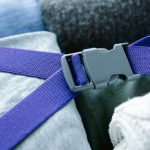When it comes to maintaining waterproof fabrics, you might find that a few simple practices can significantly extend their lifespan and effectiveness. You'll want to consider how you wash and dry these materials, as well as how often you should reapply water repellents. Many people overlook the importance of proper storage and inspection for damage, which can lead to unnecessary wear and tear. If you're curious about the best methods to keep your gear in top shape and ready for any weather, there are some key strategies that can make all the difference.
Table of Contents
Key Takeaways
- Use mild detergents and avoid fabric softeners to preserve waterproof coatings and functionality.
- Wash waterproof items in cold water on a gentle cycle, and keep them separated from other fabrics.
- Air dry in a well-ventilated area, avoiding direct sunlight and heat sources to maintain waterproof properties.
- Regularly reapply water repellent treatments to enhance moisture resistance and extend the fabric's lifespan.
Understanding Waterproof Fabrics
Waterproof fabrics are specifically designed to keep moisture out, making them essential for outdoor gear and apparel. You'll find these fabrics utilized in jackets, tents, and footwear, ensuring you stay dry during various weather conditions.
At the core of waterproof materials is a special barrier, often made from membranes or coatings that prevent water from penetrating while allowing moisture vapor to escape, keeping you comfortable.
When you choose waterproof gear, it's crucial to understand the difference between waterproof and water-resistant. Waterproof fabrics can withstand heavy rain, while water-resistant materials may only repel light moisture.
Look for features like sealed seams and durable water repellent (DWR) treatments that enhance the fabric's performance.
Proper Washing Techniques
When washing your waterproof fabrics, it's essential to choose mild detergents that won't damage the material.
Avoid fabric softeners, as they can compromise the waterproofing.
Lastly, always wash in cold water to help maintain the fabric's integrity and performance.
Choose Mild Detergents
Choosing mild detergents regularly helps preserve the integrity of waterproof fabrics during washing. Harsh chemicals can break down the protective coatings on these materials, leading to reduced water resistance. When selecting a detergent, look for those labeled as gentle or designed specifically for technical fabrics. These options typically lack the aggressive ingredients found in stronger detergents.
Before washing, check the care label on your waterproof garment. It'll provide specific instructions regarding temperature and washing methods. Always rinse your items thoroughly to remove any detergent residue that could interfere with their performance.
When washing, use a gentle cycle to minimize agitation, which can also damage the fabric. If possible, consider using a mesh laundry bag to protect your waterproof items from snagging or rubbing against other clothes.
Remember to wash waterproof fabrics separately from regular laundry to avoid any cross-contamination with lint or residues from harsher detergents. By choosing mild detergents and following these care tips, you'll help ensure your waterproof gear remains effective and lasts for many adventures to come.
Avoid Fabric Softeners
Fabric softeners should be avoided, as they can leave a residue that significantly reduces the water-repellent properties of your gear.
When you wash waterproof fabrics, you want to ensure they maintain their functionality, and fabric softeners can interfere with that. Instead of enhancing your clothing, they create a barrier that prevents water from beading off effectively.
Here are some tips to keep in mind when washing your waterproof gear:
- Use mild detergents: Stick to gentle, non-toxic options designed for technical fabrics.
- Wash separately: Avoid mixing waterproof items with regular laundry to prevent contamination.
- Check care labels: Always follow the manufacturer's instructions for washing to preserve the fabric's integrity.
Wash in Cold Water
Washing your waterproof fabrics in cold water helps preserve their water-repellent qualities and prevents damage from heat. Hot water can break down the fabric's protective coating, making it less effective against moisture. When you wash in cold water, you maintain that crucial barrier, ensuring your gear stays functional and durable.
Before you toss your waterproof items in the washer, check the care label for specific instructions. If your fabrics are particularly dirty, consider pre-treating stains with a gentle, cold-water solution. When loading the machine, avoid overcrowding; this allows your items to move freely and get properly cleaned.
Use a mild detergent designed for technical fabrics—stay clear of harsh chemicals or fabric softeners, as they can hinder water resistance. Once the cycle is complete, skip the dryer. Instead, hang your items to air dry, as heat can also compromise their waterproof features.
Drying and Drying Methods
When it comes to drying your waterproof fabrics, you've got a few options to consider.
Air drying is gentle and effective.
However, if you choose machine drying, be cautious to prevent damage.
Also, remember to avoid direct heat, as it can compromise the fabric's integrity.
Air Drying Techniques
To preserve the integrity of waterproof fabrics, you'll want to air dry them properly after cleaning. Air drying not only helps maintain the waterproof barrier but also prevents damage that can occur from high heat.
Here are some effective air drying techniques to keep in mind:
- Choose a Well-Ventilated Area: Pick a spot with good airflow to help moisture evaporate quickly.
- Avoid Direct Sunlight: Excessive UV exposure can degrade the fabric's waterproofing over time, so opt for a shady area.
- Hang or Lay Flat: Hanging your item allows for even drying, while laying it flat on a clean, dry surface can prevent stretching or warping.
After washing, give your waterproof item a gentle shake to remove excess water before air drying. This simple step can make a big difference in how quickly your fabric dries and how well it maintains its waterproof qualities.
Machine Drying Cautions
Machine drying can compromise the waterproof qualities of your fabrics, so it's crucial to proceed with caution.
First, always check the care label on your garment. Some waterproof fabrics might specifically mention that machine drying isn't recommended. If the label allows it, use a low heat setting to minimize the risk of damaging the fabric's coating.
When you machine dry, avoid overloading the dryer. This ensures that air circulates properly, allowing the moisture to escape without causing friction that could wear down the fabric. You should also consider using dryer balls; they can help separate the items and improve airflow, which can assist in a more efficient drying process.
After drying, inspect your fabric for any signs of wear or damage. If you notice any deterioration, it might be time to reapply a waterproofing treatment.
Lastly, always remember that while machine drying can be convenient, air drying remains the safest method to preserve the integrity of your waterproof fabrics. If you can, opt for air drying to extend the life of your garments and maintain their protective qualities.
Avoiding Direct Heat
Direct heat sources, like radiators or hair dryers, can significantly damage waterproof fabrics, so it's best to keep them at a safe distance during the drying process. Excessive heat can break down the material's waterproofing properties, causing it to lose effectiveness. Instead of relying on high temperatures, opt for gentler drying methods to preserve your gear.
Here are some effective tips to ensure your waterproof fabrics remain intact:
- Air Dry: Hang your items in a well-ventilated area, allowing natural airflow to help them dry without heat.
- Use a Towel: Lay your fabric flat on a dry towel to absorb moisture, then roll it up to gently press out excess water.
- Drying Rack: Utilize a drying rack to elevate your fabric off surfaces, promoting airflow underneath.
Reapplying Water Repellent
Reapplying a water repellent can significantly enhance your fabric's ability to resist moisture and extend its lifespan. Over time, the original treatment on your waterproof gear can wear off due to wear and tear, exposure to elements, or frequent washing. To maintain that protective barrier, you'll want to reapply the water repellent regularly.
Start by cleaning the fabric according to the manufacturer's instructions. Dirt and grime can prevent the repellent from adhering properly, so make sure it's spotless. Once dry, choose a suitable water repellent spray or wash-in treatment designed for your specific fabric type.
When applying, work in a well-ventilated area. If you're using spray, hold the can at a distance of about 6 to 8 inches and apply an even coat. Don't forget to cover seams and high-contact areas, as they're more prone to moisture penetration.
After applying, let your fabric dry completely before using it. For optimal results, consider reapplying the water repellent after several washes or if you notice water not beading up on the surface.
Keeping your gear treated ensures you stay dry and comfortable, no matter the conditions.
Storing Waterproof Gear
After ensuring your waterproof gear is treated with a fresh coat of water repellent, proper storage becomes key to maintaining its protective qualities. The way you store your gear can significantly impact its longevity and performance. To keep it in top shape, follow these simple guidelines:
Clean Before Storing: Make sure your gear is clean and dry before putting it away. This prevents mold and mildew from forming.
Avoid Compression: Don't cram your gear into tight spaces. This can damage the waterproof coating and fabric integrity.
Store in a Cool, Dry Place: Keep your gear in a well-ventilated area away from direct sunlight and moisture, which can degrade the materials over time.
Use Breathable Bags: Consider using breathable storage bags instead of plastic ones. This allows moisture to escape, preventing dampness and odors.
Repairing Damaged Fabrics
Repairing damaged waterproof fabrics is crucial to restoring their effectiveness and prolonging their lifespan. When you notice tears, punctures, or worn areas, addressing them promptly will prevent further damage.
Start by inspecting the fabric closely to identify the extent of the damage. For small tears, you can use a waterproof adhesive patch or fabric repair tape. Clean the area around the tear, apply the patch, and press firmly to secure it.
For larger holes or rips, you might consider sewing. Use a heavy-duty needle and outdoor thread designed for waterproof materials. Sew the edges of the tear together, then seal the stitching with a waterproof seam sealer to prevent water from seeping through.
If the waterproof coating is compromised, you can reapply a durable water repellent (DWR) treatment. Follow the manufacturer's instructions for application, usually after washing the fabric.
Frequently Asked Questions
Can I Iron Waterproof Fabrics Without Damaging Them?
You shouldn't iron waterproof fabrics. The heat can damage the waterproof coating, causing it to lose effectiveness. Instead, if you need to smooth out wrinkles, consider using a steamer or hanging it in a humid environment.
What Types of Fabrics Are Typically Waterproof?
You'll find that materials like nylon, polyester, and Gore-Tex are typically waterproof. These fabrics often have coatings or treatments that repel water, making them ideal for outdoor gear and clothing designed to keep you dry.
How Often Should I Reapply Water Repellent?
You should reapply water repellent every few months, or after heavy use or washing. Pay attention to the fabric's appearance; if water isn't beading up, it's time to refresh the treatment for optimal protection.
Are There Specific Detergents for Waterproof Fabrics?
Yes, there are specific detergents designed for waterproof fabrics. You'll want to avoid regular laundry detergents, as they can strip water-repellent coatings. Look for gentle, specially formulated options to maintain your fabric's performance.
Can I Use Fabric Softener on Waterproof Materials?
You shouldn't use fabric softener on waterproof materials. It can leave a residue, reducing their effectiveness. Instead, stick to recommended detergents that maintain the fabric's integrity and ensure that your gear stays functional and protective.
- Tetron Fabric for Marine Applications: Durability and Use Cases - June 18, 2025
- Tetron Fabric for Outdoor Furniture: Weather Resistance and Care - June 18, 2025
- Tetron Fabric for Wall Coverings: Style and Application Tips - June 18, 2025




